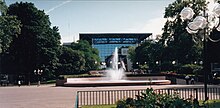Lyon-Perrache train station
| Lyon Perrache | |
|---|---|
 Entrance area of the train station with the pedestrian walkway leading through the reception building
|
|
| Data | |
| Location in the network | Junction station |
| Platform tracks | 17th |
| opening | 1857 |
| Architectural data | |
| architect | Alexis Cendrier |
| location | |
| City / municipality | Lyon |
| Department | Rhône department |
| region | Auvergne-Rhône-Alpes |
| Country | France |
| Coordinates | 45 ° 44 '54 " N , 4 ° 49' 32" E |
| meters above sea | 174 m |
| Railway lines | |
| List of train stations in France | |
The Lyon-Perrache station is the second most important station in the French metropolis of Lyon after the Lyon-Part-Dieu station. The separation station , built on brick arches of the viaduct , was opened to traffic in 1857 and was the city's main station for a long time .
location
The station is located near the city center in the 2nd arrondissement of the same name . Its tracks cut through the Presqu'île peninsula , located between the Rhone and the Saône , from north-west to south-east, with a section to the south that was opened in 2000 and serves the traffic towards Saint-Étienne . The station building is on the north side of the track field.
history

On November 12, 1845, the responsible ministry designated the Perrache district as the location of the future Lyon train station. It was built between April 1855 and June 1857 by the architect François-Alexis Cendrier for the Compagnie du chemin de fer de Paris à Lyon (PL). Due to its central location, it became the city's main train station and, with the new routes to Grenoble and Geneva, it became a hub for passenger traffic. As such, he soon needed additional tracks and an extension of the reception building, for which the first proposals were made as early as 1863. Freight traffic, however, concentrated after the opening of the Caluire tunnel at the Lyon-Brotteaux and Lyon-Saint-Clair stations .
In addition to the first station concourse from 1857, the 25 m wide Saint-Étienne hall was built in 1890 and two passenger tunnels were laid to the platforms. In 1913, 1921, 1922 and 1926 the station building was expanded. In 1928/29 the halls were underpinned and supported on common iron pillars. The construction of a cantilever on the south side made it possible to create three more tracks and a fifth platform.
In 1955 a reception pavilion was built for the Foire de Lyon trade fair and in 1976 a transfer point was opened north of the reception building with the Center d'échanges , which initially included a car park, a motorway junction and a bus station. In 1978 the Center d'échanges was connected to the city's subway network and has since been the starting point for line A. In 1980/81, the pedestrian walkway over the tracks was extended on both sides, through the reception building to the Center d'échanges. In order to avoid the previously necessary change of direction of the trains to and from Saint-Étienne, new tracks and platforms were built in the north-south direction in 2000.
In 2001 a tram stop including an end loop was added, in 2005 the tram line T1 was extended under the viaduct of the station towards the southern tip of the peninsula.
BB 1623 in front of Corail coaches in the main hall, 1984
Class Z 7100 railcars on the eastern stump tracks, 1984
traffic

In the 1950s, among other things, the Mistral express train was introduced, which connected Paris via Lyon-Perrache and Avignon (now Avignon-Center) with Marseille-Saint-Charles and provided the fastest connection between southern France and the capital.
On October 27, 1981, the TGV era was heralded at Perrache station , it became the end point of the high-speed line LGV Sud-Est from Paris. But just two years later, its importance declined rapidly when the Part-Dieu train station opened in the east of the city . Most of the TGV connections have been relocated to the new station; to this day, only ending and beginning connections to and from Paris remain in Perrache, which also stop in Part-Dieu.
Its importance in terms of transport technology has decreased significantly since 1983, but it is still served by a few TGV trains per day. In the past he even had an international connection to Turin and Milan with the TEE Mont-Cenis - the TGV trains introduced as a replacement now run via the Lyon-Saint-Exupéry TGV airport station . The international direct connections from Perrache station are limited to the regional express trains to Cornavin station in Geneva .
railroad
In addition to TGV connections, Corail Intercité connections also operate and it is also an important regional hub.
- TGV Lyon Perrache – Lyon Part-Dieu – Paris / Nantes / Rennes / Brussels / Nancy
- Intercités Nantes – Lyon Perrache
The TER Rhône-Alpes connects the station with Geneva, Grenoble, Saint-Etienne, Evian and Bourg-en-Bresse.
city traffic
The local transport hub built next to the train station in the 1970s is connected to numerous lines of various transport systems. In addition to 14 bus lines, the A metro line and the T1 and T2 tram lines also serve Perrache station. Line T1 runs to Part-Dieu station without changing trains.
Web links
Individual evidence
- ↑ a b c Gare de Lyon-Perrache at culture.gouv.fr, accessed on January 28, 2018
- ↑ a b Le center d'échanges de Perrache at millenaire3.com, accessed on January 28, 2018







